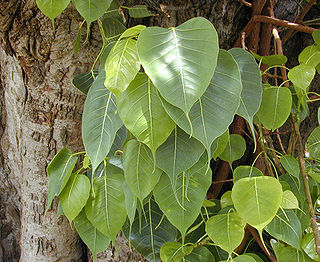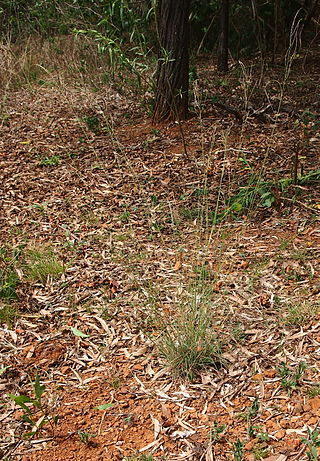Nirvāṇa is a concept in Indian religions that represents the ultimate state of soteriological release, the liberation from duḥkha, suffering, and saṃsāra, the cycle of birth and rebirth.

Yoga is a group of physical, mental, and spiritual practices or disciplines which originated in ancient India and aim to control (yoke) and still the mind, recognizing a detached witness-consciousness untouched by the mind (Chitta) and mundane suffering (Duḥkha). There is a wide variety of schools of yoga, practices, and goals in Hinduism, Buddhism, and Jainism, and traditional and modern yoga is practiced worldwide.

Vinayak Narahari Bhave, also known as Vinoba Bhave, was an Indian advocate of nonviolence and human rights. Often called Acharya, he is best known for the Bhoodan Movement. He is considered as National Teacher of India and the spiritual successor of Mahatma Gandhi. He was an eminent philosopher. The Gita has been translated into the Marathi language by him with the title Geetai.

Om is a symbol representing a sacred sound, syllable, mantra, and an invocation in Hinduism. Its written representation is one of the most important symbols of Hinduism. It is variously said to be the essence of the supreme Absolute, consciousness, Ātman,Brahman, or the cosmic world. In Indic traditions, Om serves as a sonic representation of the divine, a standard of Vedic authority and a central aspect of soteriological doctrines and practices. The syllable is often found at the beginning and the end of chapters in the Vedas, the Upanishads, and other Hindu texts.

Swami Dayananda Saraswati was a renunciate monk of the Hindu Saraswati order of sannyasa. He was also known as Pujya Swamiji and was a traditional teacher of Advaita Vedanta. He was the founder of the Arsha Vidya Gurukulams in Pennsylvania, USA; Rishikesh, Uttarakhand and Coimbatore Tamil Nadu, India. He was also the spiritual Guru of Prime Minister Narendra Modi. He was awarded the Padma Bhushan,, for his service to the nation in the field of spiritualism in 2016.

Eknath Easwaran was an Indian-born spiritual teacher, author and translator and interpreter of Indian religious texts such as the Bhagavad Gita and the Upanishads.

Pranayama is the yogic practice of focusing on breath. In yoga, breath is associated with prana, thus, pranayama is a means to elevate the prana-shakti, or life energies. Pranayama is described in Hindu texts such as the Bhagavad Gita and the Yoga Sutras of Patanjali. Later in Hatha yoga texts, it meant the complete suspension of breathing. The pranayama practices in modern yoga as exercise are unlike those of the Hatha yoga tradition.

Jnana yoga, also known as the jnanamarga, is one of the three classical paths (margas) for moksha (liberation) in Hinduism, which emphasizes the "path of knowledge", also known as the "path of self-realization". The other two are karma yoga and bhakti yoga. Modern interpretations of Hindu texts have yielded systems, techniques and formulations such as raja yoga and kriya yoga.
The word Bhagavan, also spelt as Bhagwan, an epithet within Indian religions used to denote figures of religious worship. In Hinduism it is used to signify a deity or an avatar, particularly for Krishna and Vishnu in Vaishnavism, Shiva in Shaivism and Durga or Adi Shakti in Shaktism. In Jainism the term refers to the Tirthankaras, and in Buddhism to the Buddha.

Ficus religiosa or sacred fig is a species of fig native to the Indian subcontinent and Indochina that belongs to Moraceae, the fig or mulberry family. It is also known as the bodhi tree, peepul tree, peepal tree, pipala tree or ashvattha tree. The sacred fig is considered to have a religious significance in three major religions that originated on the Indian subcontinent, Hinduism, Buddhism and Jainism. Hindu and Jain ascetics consider the species to be sacred and often meditate under it. Gautama Buddha is believed to have attained enlightenment under a tree of this species. The sacred fig is the state tree of the Indian states of Odisha, Bihar and Haryana.
Bhāvanā literally means "development" or "cultivating" or "producing" in the sense of "calling into existence". It is an important concept in Buddhist practice (Patipatti). The word bhavana normally appears in conjunction with another word forming a compound phrase such as citta-bhavana or metta-bhavana. When used on its own, bhavana signifies contemplation and 'spiritual cultivation' generally.

Graham M. Schweig is an American scholar of comparative theology of religion, philosophy, and the history of Yoga and Bhakti. He was born in Manhattan, New York and raised in Washington, DC. He joined the faculty at Christopher Newport University in Virginia, in August, 2000, and is currently Professor of Religion and Director of Studies in Religion there. He is also Distinguished Teaching and Research Faculty at The Center for Dharma Studies at the Graduate Theological Union in Berkeley, California, beginning June, 2017.

Dhyāna in Hinduism means contemplation and meditation. Dhyana is taken up in Yoga practices, and is a means to samadhi and self-knowledge.

Jyotisar, on the bank of Jyotisar Sarovar wetland, is a Hindu pilgrimage site in the city of Kurukshetra in Haryana state of India. According to Hindu tradition, Krishna delivered the sermon of Bhagavad Gita - the doctrine of Karma and Dharma to his wavering friend Arjuna to guide him to resolve his ethical dilemma and revealed his vishvarupa to him.

The Bhagavad Gita, often referred to as the Gita, is a 700-verse Hindu scripture, which is part of the epic Mahabharata. It forms the chapters 23–40 of book 6 of the Mahabharata called the Bhishma Parva. The work is dated to the second half of the first millennium BCE.
Desmostachya is a genus of grass in the family Poaceae. It is native to Africa and Asia.

Leptochloa is a widespread genus of Asian, African, Australian, and American plants in the grass family.

The Gītā Dhyānam, also called the Gītā Dhyāna or the Dhyāna Ślokas associated with the Gītā, is a 9-verse Sanskrit poem that has often been attached to the Bhagavad Gita, one of the most important scriptures of Hinduism. In English, its title can be translated literally as "meditation on the Gita," and it is also sometimes called the Invocation to the Gita.
Swami Shyam, born in Chandani, Jalaun district, Uttar Pradesh, India, was raised in the Vedic tradition of Knowledge of the Self (Atma-gyan). Shyam has meditated, studied and been dedicated to this tradition since his early childhood, when his father invited Swami Ramanand, a guru from Uttar Pradesh, to live in their home. Swami Ramanand initiated the young Shyam in meditation, and the family home became a meeting place for satsang for those who lived in the region. Ramanand taught the Vedas, the Bhagavad Gita, the Srimad Bhagavatam and other scriptures, as well as meditation. In 1973 Shyam moved to Kullu, Valley of Gods, Himachal Pradesh, India.

The Bhagavad Gita As It Istrial in Russia was a trial that commenced in 2011 about banning the Russian edition of the book Bhagavad Gita As It Is (1968), a translation and commentary of the Hindu holy text Bhagavad Gita, on charges that the commentaries fomented religious extremism. It contains a translation and commentary by A.C. Bhaktivedanta Swami Prabhupada, founder of the International Society for Krishna Consciousness (ISKCON), commonly known as the Hare Krishna movement.
















